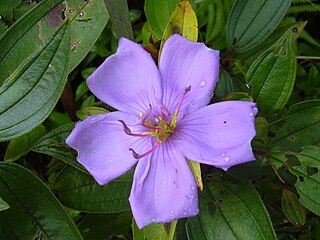
Melastoma is a genus in the family Melastomataceae. It has over 100 species distributed around Southeast Asia, India, north to Japan, south to Australia and the Pacific Islands. The number of species should probably be reduced according to some sources. Many species have been planted around the world for the aesthetic value of their bright purple flowers.

Pieter B. Pelser is a Lecturer in Plant Systematics and the curator of the herbarium at the University of Canterbury in Christchurch, New Zealand. One research interest is the evolutionary history of the tribe Senecioneae, one of the largest tribes in the largest family of flowering plants. He wrote the most recent attempt to define and delimit this tribe and its problematic founding species Senecio. He also studies insects that eat these plants (Longitarsus) which contain pyrrolizidine alkaloids and what makes them choose which plants they eat.
Rafflesia philippensis is a parasitic plant species of the Rafflesiaceae family that was named by Francisco Manuel Blanco in his Flora de Filipinas in 1845. The species is known only from a mountain located between the provinces of Laguna and Quezon, Luzon where it was first discovered. Its plant host is Tetrastigma pisicarpum. This species went unnoticed since its first description by Blanco but was rediscovered in 2003 by members of the Tanggol Kalikasan, a local environment conservation group in Quezon province who first saw and photographed the open flower of this species. It was brought to the attention of Manuel S. Enverga University (MSEUF), who formed a team composed of students and faculty to document the newly discovered Rafflesia species.
Rafflesia leonardi is a parasitic plant species of the genus Rafflesia. It is endemic to the Philippines. Rafflesia banaoana is considered to be a synonym by some sources, but is recognized as a separate species by others. R. leonardi is the fourth Rafflesia species found in Luzon and the eighth from the Philippines. It is called ngaratngat by the local Agta tribesmen.
Rafflesia manillana is a parasitic plant species of the genus Rafflesia. It is endemic to the Philippines.

Rafflesia schadenbergiana is a parasitic plant species of the genus Rafflesia. Known as "bó-o" to the Bagobo tribe and "kolon busaw" to the Higaonon tribe of Bukidnon, it has the largest flower among the Rafflesia species found in the Philippines with a diameter ranging from 52 to 80 centimeters. It has also the second largest flower in the genus after R. arnoldii.

Rafflesia speciosa is a parasitic plant species of the genus Rafflesia. It is endemic to the Philippine island of Panay. R. speciosa is the third Rafflesia species documented to exist in the Philippines, after R. manillana and R. schadenbergiana. It belongs to the medium-sized Rafflesia. The species was named by Julie Barcelona and Edwino Fernando.
Rafflesia aurantia is a member of the genus Rafflesia. It is a parasitic flowering plant endemic to Luzon Island, Philippines in the Quirino Protected Landscape. See original publication and a review of Philippine Rafflesia.

Rafflesia verrucosa was first identified and characterized during a small mammal survey of Mt. Kampalili in eastern Mindanao in 2010. R. verrucosa is the tenth species of Rafflesia found in the Philippines. Rafflesia species have rare and unusual flowers known for their large size and pungent smell. Some plant enthusiasts like Frits W. Went have gone to extreme measures to see these plants in bloom. Went detailed his search for Rafflesia saying,
"I had heard, when I was in Java many years ago, that Rafflesia were to be found on an offshore island named Nusah Kembangan. This was in 1929, when it was a penal colony for major criminals. My driver on this occasion was a convicted murderer, and my guide was serving time for cannibalism."
Julie F. Barcelona is a Filipina botanist and taxonomist working as Research Associate at University of Canterbury. She is mostly known for her research on the Philippine members of the genus Rafflesia.
Balanophora coralliformis, sometimes known as coral plant, is a flowering plant in the family Balanophoraceae and is only known from Mount Mingan on the island of Luzon in the Philippines. Like others in its genus, it is an obligate parasite growing on the roots of rainforest trees, but differs in that its tuber appears above ground and has an elongated, repeatedly branched, coral-like structure. It was first described in 2014 and is known from fewer than 50 plants, but has not as yet been declared endangered.
Nepenthes barcelonae is a tropical pitcher plant native to the Philippine island of Luzon. It is known from a single mountain in the Sierra Madre range of Aurora Province, where it grows in stunted submontane forest.

Daniel Lee Nickrent is an American botanist, working in plant evolutionary biology, including the subdisciplines of genomics, phylogenetics, systematics, population genetics, and taxonomy. A major focus has been parasitic flowering plants, particularly of the sandalwood order (Santalales). His interest in photographic documentation and photographic databases has led to several photographic databases including Parasitic Plant Connection, Phytoimages, Plant Checklist for the Rocky Mountain National Park, and Plant Checklist for the Crab Orchard National Wildlife Refuge.
Amyema lisae, is a species of flowering plant, an epiphytic hemiparasitic plant of the family Loranthaceae first discovered in 2017 at Balinsasayao - Twin Lakes Natural Park, in the island of Negros, Philippines. Amyema lisae differs due with verticillate arrangements of leaves and simple umbels in the inflorescences. Its leaves are also relatively smaller leaves. The 5-merous flowers are tomentose and yellow, making it the only mistletoe species in the Philippines to have a yellow flower.
Amyema nickrentii is an epiphytic, flowering, hemiparasitic plant of the family Loranthaceae native to the Philippines. It was found in coastal forest in the Aurora Province and "differs from all other described Amyema species in having a whorled leaf arrangement with mostly nine flat linear leaves per node".
Dendrochilum ignisiflorum is a species of orchid endemic in Benguet province in the Philippines.
Begonia cabanillasii is a species of flowering plant in the family Begoniaceae, native to the island of Palawan in the Philippines.

Begonia caramoanensis is a species of flowering plant in the family Begoniaceae, native to the island of Luzon in the Philippines.
The Philippine Taxonomic Initiative (PTI) is a private Philippine research institute and non-profit organization located in Palawan.
Danilo Tandang is a Filipino botanist, working in the National Museum of the Philippines, Philippines






